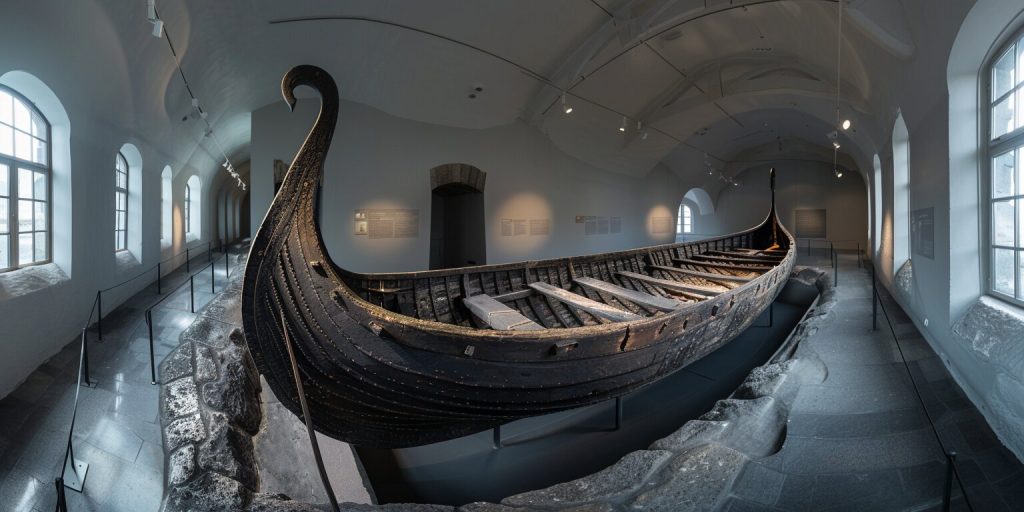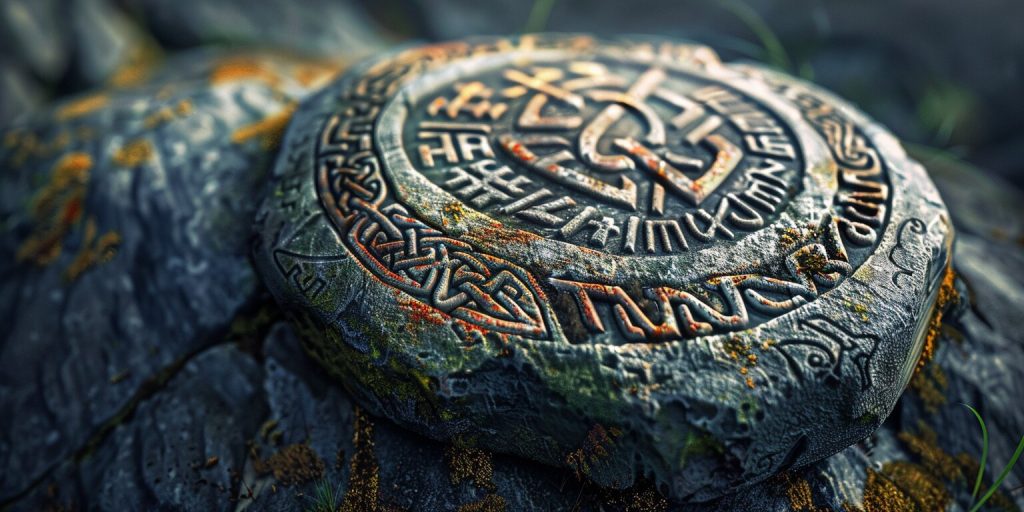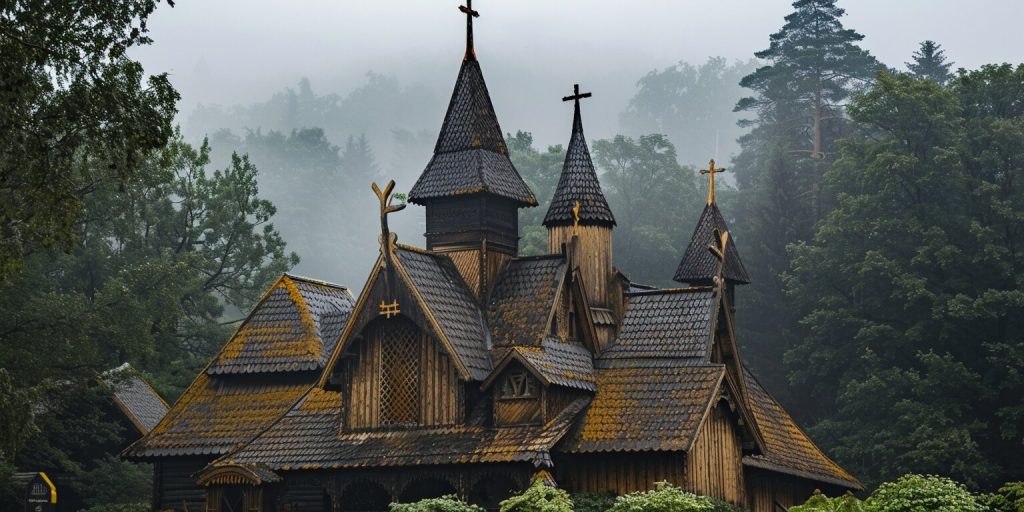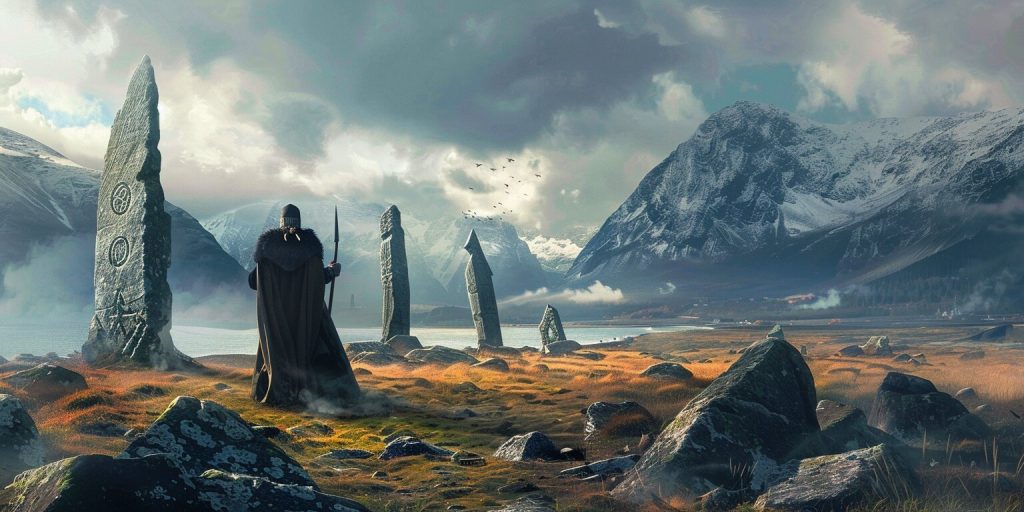Viking Heritage, Vikings
Are There Any Viking Monuments?
Have you ever considered ancient Viking monuments? They give us a peek into the rich history of Scandinavia and beyond. These monuments are like silent storytellers from the Viking age.
They range from tall runestones to hidden burial mounds. Each one tells us about the Vikings’ conquests, trade, and spiritual beliefs. You can find them all over northern Europe and even in North America. They show us the Vikings’ art and culture and how they interacted with others.
Want to learn more about these ancient relics? Let’s explore the world of Viking monuments together, where many incredible Viking tales await discovery. We’ll uncover the secrets of our Norse ancestors.
The Legacy of Viking Monuments
Viking monuments are lasting symbols of Norse culture and history. They show us the lives of important Viking figures and their society. From tall runestones to detailed ship burials, each one tells a unique story of Viking heritage.
Defining Viking Monuments
Viking monuments list includes many structures and objects from the Viking Age. These range from burial mounds to stone carvings and archaeological sites within the viking world. Each one is a window into the past, showing us Norse life, beliefs, and achievements.
Historical Significance
The historical importance of Viking monuments is huge. They connect us to a long-lost era, helping researchers understand Viking society. Many sites have given us key insights into Viking daily life, warfare, and trade. These findings keep shaping our view of this interesting time in history.
Types of Viking Monuments
Viking monuments vary, each with its own importance, attracting viking fans from around the world:
- Runestones: Carved stones with runic inscriptions
- Burial mounds: Large structures for Viking leaders’ remains
- Ship burials: Elaborate tombs with preserved Viking ships
- Fortifications: Defenses that protected Viking settlements
- Religious sites: Places of worship showing Viking spiritual beliefs
These monuments give us a rich view of Viking heritage. They provide deep insights into the lives and customs of these ancient Norse people.
Famous Viking Monuments in Norway
Norway is home to many Viking monuments showing its rich history, including the island of Vestvågøya, dotted with ancient viking sites. These sites are like time capsules from the Viking Age. They draw in history lovers, viking fans, and those just curious about the past.
The Oseberg ship burial near Tønsberg is a top spot for Viking history in Norway. It has a well-preserved Viking ship and many artifacts. This place gives us a peek into Viking life and how they buried their dead.
Don’t miss the Borre Mound Cemetery in Vestfold. It’s one of the biggest viking sites in Scandinavia, with seven big mounds and many small ones. The museum there has artifacts from digs, giving a full view of Viking culture.
Another key Viking site is the Gokstad ship, found in a burial mound near Sandefjord. This almost whole ship from the ninth century shows how skilled the Vikings were in building ships.

The Jelling stones in Jutland are great for runestone enthusiasts. These huge stones tell of Viking rulers and Denmark’s switch to Christianity.
These Viking monuments Norway do more than just tell history. They let visitors feel like they’re back in the time of the Norse people. It’s a way to connect with the past.
Viking Monuments Inscribed as UNESCO World Heritage Sites
Viking heritage lives on through several extraordinary sites recognized by UNESCO as world heritage treasures. These properties appointed as Viking Age world landmarks offer a glimpse into the rich Norse culture and its lasting impact.
Jelling Mounds, Runic Stones, and Church
In Denmark, the Jelling complex stands as a testament to Viking ingenuity. This UNESCO World Heritage site features two massive burial mounds and two runic stones. The larger stone, known as Denmark’s “birth certificate,” bears the earliest depiction of Christ in Scandinavia.
Birka and Hovgården
Sweden’s Birka and Hovgården, located on separate islands in Lake Mälaren, represent a significant Viking Age trading center. This world heritage site includes well-preserved remains of a fortified trading town, offering insights into the Vikings’ extensive commercial networks.
Urnes Stave Church
Norway’s Urnes Stave Church, another UNESCO World Heritage gem, showcases the transition from Viking to Christian art. Built around 1130 AD, it features intricate wood carvings that blend pagan and Christian motifs, reflecting the cultural shift of the time, much like the intricate designs found in a historic viking temple.
These Viking monuments, appointed as UNESCO World Heritage sites, preserve invaluable aspects of Norse history. They provide tangible links to a fascinating era, allowing visitors to step back in time and experience the legacy of the Vikings firsthand.
The Viking Ship Museum: A Treasure Trove of Maritime Heritage
The Viking Ship Museum in Oslo is a key place to learn about Norse maritime skills. It has a big collection of Viking ships, showing us the seafaring life of ancient Scandinavia. At the heart of the museum are five Viking ships, each with its own story of Viking craftsmanship and exploration.
The Oseberg and Gokstad ships are highlights of the museum. They showcase the detailed woodwork and shipbuilding skills of the Viking Age. The Oseberg ship is known for its beautiful carvings, which show the Vikings’ artistic side. The Gokstad ship, on the other hand, was made for practical use and to withstand the sea.
The museum also has a wide range of Viking artifacts. These include tools, fancy items for burials, and more, giving us a peek into Viking life. You can see sleds, household items, and weapons, all found in Viking burial sites.
The museum is more than just a place to look at things. It’s also a center for research, learning more about Viking ships and culture. By studying these old ships, researchers learn about how Vikings built their ships and sailed the seas.
If you’re interested in Norse history, you should definitely visit the Viking Ship Museum in Oslo. It brings the Viking Age to life, allowing you to experience the maritime world of these famous sailors.
Exploring Viking Burial Sites and Their Monuments
Viking burial sites give us a peek into the rich culture and beliefs of Norse society. They also reveal fascinating details about Viking life and death rituals. Let’s examine some key Viking burial locations and their monuments.
Oseberg Ship Burial
The Oseberg ship burial is one of the best-preserved Viking sites, an incredible viking marvel that has fascinated archaeologists. Found in Norway, it dates back to the ninth century and is considered one of the best Viking sites. Inside, archaeologists found the remains of two women and many artifacts at this authentic Viking site. The wooden ship is a masterpiece of Viking craftsmanship.
Gokstad Ship Burial
The Gokstad ship burial is another important site. It was the final rest for a powerful Viking chieftain, possibly even a viking king. The ship is one of the biggest Viking ships ever found. It also had many burial goods, showing Viking social ranks.
Borre Mound Cemetery
The Borre Mound Cemetery is a huge burial ground in Norway, known as one of the top viking archaeological sites. It was a place where Viking nobles rested for centuries. Its size shows its big role in Viking society. Archaeologists are still learning about Viking burial customs and social setups from this site.
These Viking burial sites are crucial for understanding Norse culture. They reveal the Vikings’ views on the afterlife and their respect for the dead. The artifacts found help us connect with the Viking age, letting us see what life was like back then in the incredible viking communities.
Viking Monuments: Rune Stones and Their Significance
Runestones are amazing viking monuments with ancient Norse writing. They were used as memorials to mark big events and honor viking leaders. These stones are found all over Scandinavia, showing us the rich culture of the Viking Age.
Viking artists carved these stones with detailed designs and runic messages. The messages often discussed brave actions, successful trips, or family histories. Some stones even shared information about trade paths and battles, which helps historians today.
Runestones were placed near roads or meeting spots so many people could see them. This way, they kept the memory of key people and events alive in Viking society, making it an integral part of the viking world. These stones are key artifacts from the Viking Age, giving us a peek into Norse language, art, and social life.

Archaeologists and historians continue to examine runestones to learn more about Viking life. These monuments connect us to the past, helping us better understand our Norse ancestors. By studying these ancient inscriptions, we more deeply appreciate the lasting impact of Viking culture, reaffirming its value as one of the best Viking sites.
Reconstructed Viking Villages: Living Monuments to Norse Culture
Step back in time to reconstructed Viking villages, often featured at Viking festivals. These places let you see what Norse life was like. You can walk through Viking longhouses and farms at this authentic Viking Centre. You’ll learn about their daily life from a thousand years ago.
Lofotr Viking Museum
The Lofotr Viking Museum is a top choice among Viking attractions. It’s in Borg, Lofoten, and has a big Viking chieftain’s longhouse. This longhouse is the biggest from the Viking Age and could be considered one of the largest viking houses discovered. You can try making traditional crafts and taste food from Viking times.
Borg in Lofoten
Borg in Lofoten has a rebuilt Viking village. It’s on the spot where a chieftain’s farm was in 500 AD. The village has a longhouse, boathouse, and smithy, so you can see what life was like during the Viking Age.
Avaldsnes Viking Farm
Avaldsnes Viking Farm gives you a real feel of Viking life. You can join in on daily Viking activities and learn about farming, crafts, and traditions. The farm has buildings just like in Viking times.
These Viking villages are like living history. They offer hands-on learning for everyone. By visiting, you’ll understand Viking history and life better, donning viking costumes to fully immerse yourself in the experience.
Viking Age Fortresses: Defensive Monuments of the Norse
Viking fortresses were key symbols of Norse strength. They were vital for protecting Viking towns from invaders. These fortresses had smart designs with round or square shapes, big earthen walls, and wooden fences.
The Kaupang viking town in Norway is a great example. It was a busy place with strong defenses. These walls kept its people safe while still allowing trade to happen. This shows how Viking coastal towns were both safe and thriving.
Viking fortresses came in all sizes and types. Some were just wooden, while others had stone bases and fancy gatehouses. These strongholds were important for leading battles and showing off Norse power to foes.
Archaeologists have found out a lot about life in these fortresses. They’ve found workshops, homes, and places to store things, making it one of the best Viking sites in Norway. This shows that people living there were ready for long sieges.
Viking fortresses were often by the sea or rivers, perfect locations for launching Viking vessels. This helped the Vikings move quickly and control trade paths, showing their intelligence in war and business.
The Influence of Christianity on Viking Monuments
In the late Viking age, Christianity started to spread across Scandinavia. This change left its mark on Viking monuments, mixing old traditions with new beliefs. This shift marked the end of the Viking Age, leading to unique artifacts that show the change.
Stave Churches
Stave churches are symbols of the Viking journey to Christianity. Built in the 11th and 12th centuries, they mix Norse woodworking with Christian designs. The carvings often show both pagan and Christian symbols, showing how the Vikings slowly accepted Christianity and how these artifacts can be seen at Viking festivals.

Conversion Period Artifacts
As Vikings turned to Christianity in the 11th century, new artifacts appeared, often displayed at the Viking Centre. These include crosses with Thor’s hammer and pendants with both Christian and pagan symbols. These items give us a glimpse into the spiritual change Vikings went through during this time.
Syncretism in Viking Memorial Stones
Viking memorial stones from the late Viking age show how beliefs mixed. They start with pagan formulas but end with Christian prayers. This mix of old and new beliefs in one stone shows the complex spiritual change the Vikings underwent, keeping their culture while adopting new beliefs, a well-documented journey in historic viking lore.
Preserving Viking Monuments: Challenges and Techniques
Viking artifacts face many threats to their survival. Weather and pollution can harm these ancient treasures, and human actions, like tourism and building, also pose risks.
Experts use advanced methods to protect Viking monuments. They keep items in climate-controlled spaces. Special coatings protect outdoor sites from the elements. Regular checks help spot and fix problems early, ensuring the smooth functioning of the largest viking festivals.
Underwater finds often yield the best-preserved Viking artifacts. Ships and cargo have stayed well for centuries in low-oxygen areas. These discoveries give us deep insights into Viking life and culture. Archaeologists use modern tech to uncover and preserve these treasures.
Teaching the public about Viking heritage is key to preservation. When people value Viking culture, they support conservation efforts. Museums and sites offer hands-on exhibits to engage visitors. These experiences connect us to our Viking ancestors at this Viking Center.
Keeping confirmed Viking sites in good shape needs ongoing care. It’s a balance between preservation and letting people see them. Experts work hard to protect artifacts while still sharing them with us at the Viking Centre. This is crucial to keep Viking heritage alive for the future.
Viking Monuments Beyond Scandinavia: A Global Perspective
The Viking legacy goes far beyond Scandinavia. Many Viking sites and museums are found across Europe and even further. In the British Isles, you can see the remains of Norse settlements. York, once called Jorvik, is a city rich in Viking history. It shows artifacts and streets from back then, making it one of the best Viking sites.
Further away, a viking site in North America has caused a lot of debate. L’Anse aux Meadows in Newfoundland, Canada, might be the first Norse settlement in the New World. This site is a UNESCO World Heritage site with rebuilt Norse buildings that serve as a major Viking attraction. It gives us a peek into Viking exploration across the Atlantic.
Ireland also has its Viking treasures in Europe. The Viking Waterford Museum in southeastern Ireland has artifacts from the city’s Norse founders. Visitors can see a rebuilt Viking longship and check out the detailed metalwork. This connects us to the seafaring warriors who lived there, making it an authentic Viking experience.
These Viking monuments around the world show the wide reach of Norse culture. From Norway’s fjords to North America’s shores, the Viking legacy still fascinates and teaches us about this interesting time in history.

